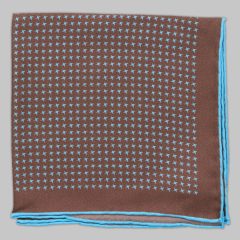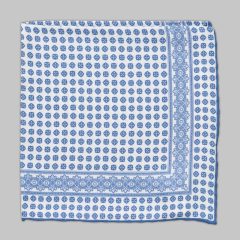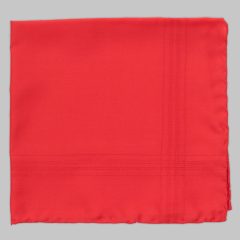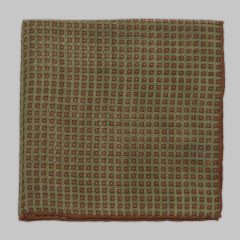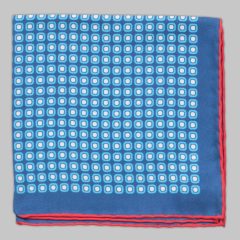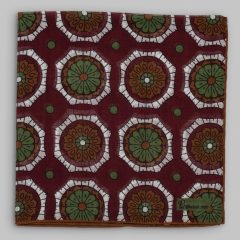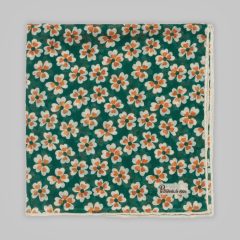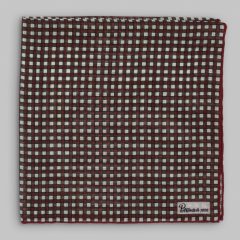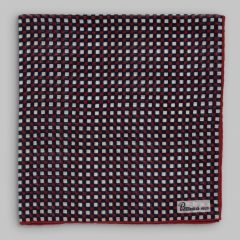Pocket Squares
The handkerchief is a multi-purpose and extremely practical accessory that has accompanied human history through the ages. From ancient China to Roman times and right up to the present day it has been with us, wiping our brows, shading us from the sun, mopping up a spill as well as giving us something to blow our noses into. In its Bandana format it was, and still is, tied around the head and neck. Apart from its practical uses it also acquired several symbolic meanings and ritual purposes.
Up until the middle ages handkerchiefs, in Europe, were made usually of white linen which was produced throughout the continent. Even today linen is used for the highest quality handkerchiefs because of its incredible ability to absorb moisture.
With the opening of the trade routes to the east silk arrived in Europe and was soon being flaunted by rich gentlemen eager to show off their wealth. An interesting fact is that sea silk has been made out of fibres collected from the pen shell since Egyptian times but its rarity, and extraordinary cost, have kept it the preserve of extremely wealthy princes.
King Richard II is credited with being the first gentleman to use handkerchiefs as a decorative accessory, instead of just as a practical item, thus he is considered the inventor of the pocket square as an accessory of display with bold patterns. In the same era jousting tournaments were very popular and ladies would give their preferred knight a token of some sort, often a handkerchief, for good luck.
In the 18th century Louis XVI limited the size of the courtiers’ handkerchiefs to 16” by 16” (40x40 cm) to curb the trend of showing off by ways of bigger and fancier styles with more and more elaborate handmade bobbin lace to flaunt their wealth. The aristocracy’s conspicuous consumption was heavily contrasted by the famine and privation of the lower classes. The elaborate handkerchief was one of the many signs of social inequality, which finally resulted in the French revolution of 1789.
It was during the 18th century that dark coloured handkerchiefs started being used instead of the usual white ones, because of the widespread use of snuff which stained white handkerchiefs and was very difficult to remove.
Handkerchiefs had their own love language by ways of signaling interest with them or even set up a rendez-vous -similarly to fans and flowers- and were used as a token of love between engaged couples or lovers. Ladies spent long hours, working often for days or weeks to embroider such handkerchiefs as a sign of their affection.
Their most sophisticated and expensive versions became indicative of social status.
It is not by accident that in Dickens’ Oliver Twist the pick-pockets specialize in stealing handkerchiefs amongst other expensive and luxurious items. Before the industrial revolution these articles were so costly to produce, due to the labour intensive nature of fine fabric production, that it was profitable to unpick the initials embroidered on them and resell them. The same applied to lace, which was also produced by hand and it could take a lace-maker weeks to create enough bobbin lace for a single handkerchief!
By the end of the 19th century, with the gradual disappearance of the frock coat and the advent of the short lounge jacket, gentlemen started to show their handkerchiefs in their jacket’s breast pocket more for display and less for practical reasons-and so the pocket square became widespread. It was common that men carried two handkerchiefs: one to be used for practical purposes and another one for decoration.
The 20th century saw the introduction of the paper tissue, and fabric handkerchiefs slowly became less common and not any longer a utilitarian necessity. Handkerchiefs became a luxury item and consequently that moved the pocket square into its contemporary position of decorative fashion accessory. It also acquired its rolled edge finish which finally distinguished it from the handkerchief.
The 1950s was the decade when a gentleman could really have fun with his fashion accessories. All of a sudden a wide variety of colours, patterns and fabrics emerge and the pocket square, again, becomes a signal of distinction. Hollywood actors, plutocrats and royalty, like Cary Grant, Gary Cooper, Luciano Barbera and the Duke of Windsor sported pocket squares, playing with the colours, patterns and textures in carefully studied combinations to demonstrate their sophisticated tastes. These leaders of masculine style were followed religiously and the pocket square remains one of the most versatile accessories for a gentleman. With the declining popularity of the tie, and the general trend moving towards more casual dressing, the pochette has taken an ever more important role in accessorizing outfits.
While the choice of a pocket square is a matter of personal taste there are a few rules that can help the novice in understanding the language of the pochette.
The choice of fabric for your pochette should contrast, not match your tie. Shiny tie, matte pochette and vice versa. Silk twill (shiny), silk/wool (matte with lustre), cotton (matte), linen (matte).
Choose a secondary colour from your outfit as a primary colour for your pocket square. So the accent colour in your jacket, or shirt, can be picked up for a dash of colour in your pochette.
Don’t directly match your tie and pocket square, the sure sign of an unsophisticated dresser, and don’t make it conspicuous. Use it for what it’s for, to express your character: serious, intellectual, whimsical our even outrageous.
Key to your statement is pattern, and again there are a few guidelines. A solid colour, maybe with a contrast edge, should echo a colour from your tie, shirt or perhaps the highlight colour in your jacket fabric.
If you are wearing a tie, and wish to combine it with a pochette of a similar pattern, choose a different scale. Small patterned tie, large version for the pochette for example.
In contrast if you wish to combine different patterns try to stick to a similar scale. This usually gives a more satisfactory balance to the outfit. In a similar way your choice of how to fold your pochette can say a lot about you. A soft puff, multiple points, irregular angle or even staged are all variations to consider depending upon whether you wish to be considered an artist or James Bond. Within these guidelines you can play as much as you want. The question is, “Does it work? And do I feel good?” And once mastered, bend the rules. Many a fantastic outfit is a combination of carefully cultivated taste and a good dose of chutzpah!





